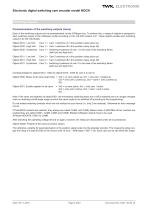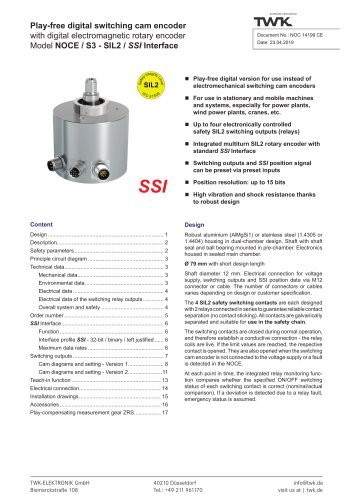
Catalog excerpts

Play-free electronic digital switching cam encoder with electromagnetic absolute encoder / CANopen Model NOCN Play-free version for use instead of electromechanical switching cam encoders For use in stationary and mobile machines and systems, particularly for wind turbines, power plants, cranes, etc. Up to six electronically controlled switching outputs consisting of - Relay: Changeover contacts - PhotoMOS: Normally open/closed contacts Integrated absolute multiturn encoder with CANopen interface Parameterisable via CANopen bus High vibration and shock resistance thanks to the robust design Option: SIL2 certificate (Datasheet NOC13099) Velocity signal via CANopen Further available versions: CANopen safety: Datasheet NOC13099 SSI: Datasheet NOC12555 SSI - SIL2: Datasheet NOC 14199 Analog: Datasheet NOC12393 - Robust housing manufactured from seawater-proof aluminium (AlMgSi1) or stainless steel (material: 1.4305 optionally 1.4404). - Shaft fitted with ball bearings bears the magnet for recording the angular position and the drive gear of the multiturn transmission for absolute revolution counting. - Shaft and transmission are located in the prechamber. Sealed off from this, the main chamber contains all electronic components for position recording, evaluation and output. - Available Versions: Ø 58 mm with different flange and shaft designs. 2 x relay and 2 x PhotoMOS at maximum. Ø 64 mm (standard) with clamping collar and M6 threaded holes plus two device connectors. 2 x relay and 2 x PhotoMOS at maximum. Ø 120 mm (optional) with clamping collar, M6 threaded holes and synchroniser groove. 4 relays at maximum. 79 mm with short housing length. Ø • 4 x relay • 4 x relay and 2 x PhotoMOS (on request) - Electrical connection for voltage supply, switching out puts and CANopen data via M12 connectors or cables. The number of connectors or cables varies depending on version or customer specifications. TWK-ELEKTRONIK GmbH Heinrichstrasse 85
Open the catalog to page 1
Electronic digital switching cam encoder model NOCN Description General functional principle Switching outputs (cams) This involves a play-free electronic switching cam encoder (abbreviated to: NOCN) with a maximum of four galvanically separated switching outputs (cams), which can be set by the customer and which are activated or deactivated depending on the relevant position of the drive shaft. A parameterisable multiturn absolute encoder with CANopen interface plus the switching cam encoder printed circuit board with separate controller are integrated into the compact housing. The...
Open the catalog to page 2
Electrical data ■ Sensor system: ■ Operating voltage range: ■ Power consumption: ■ Resolution: ■ Measuring range: ■ Meas. step deviation: ■ Absolute accuracy: ■ Repeatability: ■ Output code: ■ Code path: ■ Temperature drift: ■ Reference value: ■ Overvoltage protection and galvanic separation with CANopen bus ■ CAN interface: ■ Address setting: ■ Terminating resistor: ■ Max.transmission length: ■ EMC standards: Interference emission: Interference immunity: ■ Electrical connection: ■ CAN IC voltage rating: ASIC with HALL elements + 11 VDC to + 28 VDC < 2.5 W 4096 steps / 360° - (12-bit) or...
Open the catalog to page 3
Electronic digital switching cam encoder model NOCN Technical data Environmental data Operating temperature range: Storage temperature range: Resistance: - 40 °C to + 85 °C - 45 °C to + 85 °C 250 m/s², 6 ms, 100 x each in 3 axes 100 m/s², 5 Hz ... 2000 Hz, 1 h each in 3 axes (Higher values optional) IP67, optionally IP69K Switching output relay electrical data Maximum switching current: Maximum switching voltage: 60 VDC / VAC Note: The effective maximum voltage is dependent on the connector into which the switching contacts are integrated: M12, 12-pin: max. 30 VDC, M12, 8-pin:...
Open the catalog to page 4
^ Standard version Electrical and mechanical variants N CANopen Galvanic separation 1. See page 6: V1 -VS1 CAN_GND 1screening/housing ^ Recommended V2 -VS = CAN_GND 1screening/housing V3 -VS = CAN_GND = screening/housing Electrical connections (see remark on page 11, 12): ^ Combine kind (S, T, K, L) and number of desired connection 1 = 1 connection 2 = 2 connections 3 = 3 connections S Via device connector M12, radial T Via device connector M12, axial (at NOCN79 only on request) K Via cable, 1 m 2, radial 2 other lengths possible L Via cable, 1 m 2, axial (at NOCN79 only on request) C2...
Open the catalog to page 5
Find details on page 11 Order code number, remarks V1: This version provides complete galvanic separation. Power supply and CAN_GND is galvanically separated. The housing and the screening of the cable is galvanically separated as well. The screening of the cable comes to the housing of the NOCN via the housing of the mating plug. V2: This version provides partly galvanic separation. Power supply and CAN_GND are not galvanically separated. The housing and the screening of the cable are galvanically separated from power supply and CAN_GND. The screening of the cable comes to the housing of...
Open the catalog to page 6
Switching outputs Function The function of the switching outputs (cams) is implemented by means of relays and PhotoMOS semiconductors. The relays provide changeover contacts and the PhotoMOS semiconductors provide normally open contacts (NO). All switching outputs are galvanically separated in terms of operating voltage and the CANopen bus. The information regarding when which relay is to pick up and drop off again is made available to the relay control system by the internal controller. If receives the shaft position data from the NOCN's absolute encoder. The precise position of the...
Open the catalog to page 7
Electronic digital switching cam encoder model NOCN Switching outputs Parameterisation of the switching outputs (cams) Each of the switching outputs can be parameterised via the CANopen bus. To achieve this, a range of objects is assigned to each switching output in the CANopen profile according to CiA, DS 406 revision 4.01. These objects enable each switching output to be set individually: Object 6310: Low limit Cam 1 > Cam 1 switches on in this position (relay picks up) Object 6320: High limit Cam 1 > Cam 1 switches off in this position (relay drops off) Object 6330: Hysteresis Cam 1 >...
Open the catalog to page 8All TWK-ELEKTRONIK GmbH catalogs and technical brochures
-
Rotary encoder TBN58/C3 manual
50 Pages
-
Rotary encoder TBN58/C3
22 Pages
-
Rotary encoder TBD Manual
26 Pages
-
Rotary encoder TBD
12 Pages
-
Rotary encoder TBE58
16 Pages
-
Rotary encoder KRP - Manual
19 Pages
-
Rotary encoder KRP
7 Pages
-
Rotary encoder TBN58/S4 SIL2
22 Pages
-
Rotary encoder TBN50/C3 manual
20 Pages
-
Rotary encoder TBN50/C3
22 Pages
-
Rotary encoder HBN/S3 SIL2
16 Pages
-
Product range 2022
64 Pages
-
Image brochure TWK
28 Pages
-
Inclinometer NBA51
6 Pages
-
Incremental encoder FOI
7 Pages
-
Rotary encoder TBA42
16 Pages
-
Rotary encoder TRA42
16 Pages
-
Rotary encoder TRN58/S4 SIL2
22 Pages
-
Rotary encoder TRN58/C3 manual
50 Pages
-
Rotary encoder TRN58/C3
22 Pages
-
Rotary encoder TRN42/S4 SIL2
22 Pages
-
Manual TRN50/C3
86 Pages
-
Rotary encoder TRN50/C3
22 Pages
-
Rotary encoder TRN42/C3 manual
86 Pages
-
Rotary encoder TRN42/C3
22 Pages
-
Rotary encoder TBN42/S4 SIL2
22 Pages
-
Rotary encoder TBN42/C3 manual
86 Pages
-
Rotary encoder TBN42/C3
22 Pages
-
Rotary encoder TRE58
16 Pages
-
Rotary encoder TRT manual
40 Pages
-
Rotary encoder TRT
14 Pages
-
Switching cam encoder NOCE
14 Pages
-
Switching cam encoder NOCA
17 Pages
-
Vibration sensor NVT/S3 PLd
12 Pages
-
Vibration sensor NVA
12 Pages
-
Inclinometer NBN
17 Pages
-
Incremental encoder TBI42
6 Pages
-
Vibration sensor NVA/S3 PLd
15 Pages
-
Rotary transducer PMR411
1 Pages
-
Rotary encoder TRT/S3 SIL2
13 Pages
-
Rotary transducer VP12
1 Pages
-
Inclination sensor NBT manual
21 Pages
-
Inclination sensor NBT
10 Pages
-
Inclinometer NBA
17 Pages
-
Inclinometer NBT/S3 SIL2/PLd
12 Pages
-
Inclinometer NBN/S3 SIL2
13 Pages
-
Rotary encoder TBE50
16 Pages
-
Rotary encoder HBE
14 Pages
-
Rotary encoder TRK manual
18 Pages
-
Rotary encoder TRK
11 Pages
-
Rotary encoder TMN50 manual
22 Pages
-
Rotary encoder TMN50
6 Pages
-
Rotary encoder TRK/S3 SIL2
14 Pages
-
Rotary encoder TRE42
6 Pages
-
Rotary encoder TRE50
6 Pages
-
Rotary encoder TRA50
6 Pages
-
Rotary encoder TBE42
6 Pages
-
Rotary encoder TME42
6 Pages
-
Rotary encoder TRD manual
26 Pages
-
Rotary encoder TRD
12 Pages
-
Rotary encoder TME50
6 Pages
-
Rotary encoder TBN36
6 Pages
-
Rotary encoder TMA50
6 Pages
-
Rotary encoder TMN42 manual
22 Pages
-
Rotary encoder TMN42
6 Pages
-
Rotary encoder TMA42
6 Pages
-
Rotary encoder TBA50
16 Pages
-
Rotary encoder TBE36 manual
22 Pages
-
Rotary encoder TBE36
6 Pages
-
Rotary encoder TBN42
6 Pages
-
Rotary encoder TBN37
8 Pages
-
Rotary encoder TBA37
7 Pages
-
Rotary encoder TBB50
16 Pages
-
Rotary encoder PBA12
2 Pages
-
Rotary encoder TBA36
6 Pages
-
Rotary encoder TKA60
2 Pages
-
Rotary encoder TKN46 manual
22 Pages
-
Rotary encoder TKN46
7 Pages



































































































































